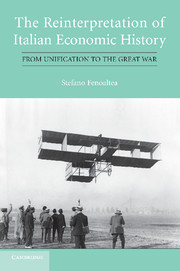Book contents
- Frontmatter
- Contents
- List of Tables
- List of Figures
- Acknowledgments
- Preface
- Introduction
- 1 The Time Series and the Interpretations
- 1A The Measurement of Production Movements
- 2 The Investment Cycle
- 3 The Consumption Cycle and the “Crisis” of the 1880s
- 4 Protection and Migration
- 5 Railways
- 6 North and South
- 6A North and South: A Sectoral Analysis
- 7 The State of Play
- APPENDICES: TARIFFS, TRADE, MIGRATION, AND GROWTH
- Appendix 1 Tariffs and Market Prices
- Appendix 2 The Ricardian Model of Trade
- Appendix 3 Migration and Relative Mobility
- Appendix 4 The Ricardian Model of Growth
- References
- Index
Appendix 2 - The Ricardian Model of Trade
Published online by Cambridge University Press: 05 March 2012
- Frontmatter
- Contents
- List of Tables
- List of Figures
- Acknowledgments
- Preface
- Introduction
- 1 The Time Series and the Interpretations
- 1A The Measurement of Production Movements
- 2 The Investment Cycle
- 3 The Consumption Cycle and the “Crisis” of the 1880s
- 4 Protection and Migration
- 5 Railways
- 6 North and South
- 6A North and South: A Sectoral Analysis
- 7 The State of Play
- APPENDICES: TARIFFS, TRADE, MIGRATION, AND GROWTH
- Appendix 1 Tariffs and Market Prices
- Appendix 2 The Ricardian Model of Trade
- Appendix 3 Migration and Relative Mobility
- Appendix 4 The Ricardian Model of Growth
- References
- Index
Summary
The gains from trade
The ricardian model of trade can be illustrated by Figure A2.01. The axes measure the physical quantities of grain and of wine; in the sense to be explained forthwith, these represent land-intensive goods (cereals), and labor-intensive goods (the products of specialized agriculture, and industry), respectively.
Curve W4–G4 is our production possibilities curve (with our given resources, and our technology); under autarky it also represents our consumption possibilities. The autarky equilibrium is, by assumption, point (1), that is, (W1, GM3). At point (1), the production possibilities curve is tangent to the “price line” (not illustrated on the graph): the slope of the former, which corresponds to the goods' relative costs, equals the slope of the latter, which corresponds to their relative prices.
In the world market, by assumption, relative prices differ: grain is relatively cheaper, the price line is correspondingly flatter. If our country opens itself to free trade, domestic relative prices align themselves to world relative prices. The production equilibrium therefore shifts from (1) to (2), that is, to the point where the slope of our production possibilities curve equals the slope of free-trade price line: “grain” production falls from G3 to G2, “wine” production grows from W1 to W2. The free-trade consumption-possibilities curve is the price line tangent, in (2), to the production possibilities curve; we can consume more “wine,” and more “grain,” than under autarky, and the new consumption equilibrium will be a point on the segment (2)–G5 above, and to the right of, point (1).
- Type
- Chapter
- Information
- The Reinterpretation of Italian Economic HistoryFrom Unification to the Great War, pp. 252 - 257Publisher: Cambridge University PressPrint publication year: 2011



